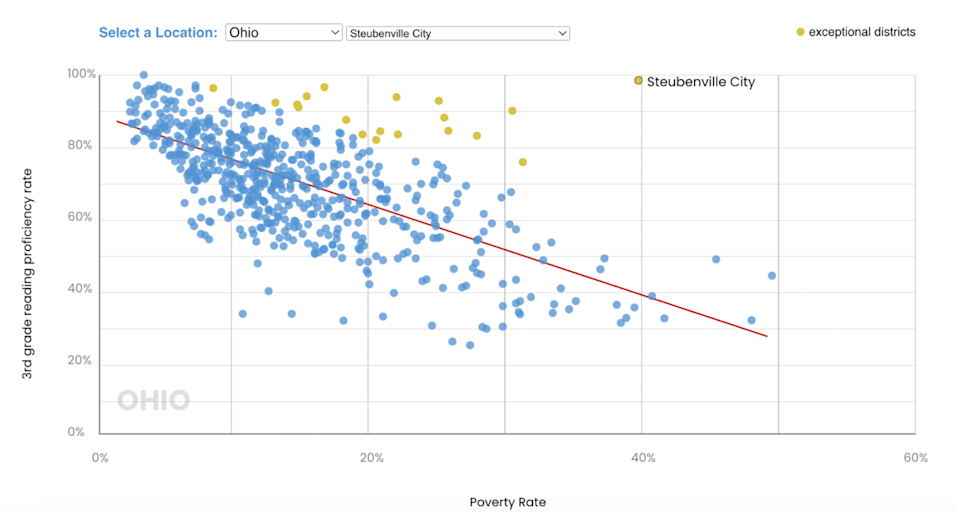There’s no more fundamental task for a school than teaching kids to read.
But what about kids living in poverty? Don’t schools need more money, and more staff, to be able to get good results?
Well, yes and no. Poverty is certainly correlated to reading scores, and the best evidence suggests money helps boost a range of student outcomes.
Get stories like this delivered straight to your inbox. Sign up for The 74 Newsletter
But that doesn’t mean the best school district in the country is the most well-resourced or the one with the fanciest buildings or most prestigious alumni. In fact, based on how much students learn — which, in my opinion, is how schools should be evaluated — there’s perhaps no better district in the country than Steubenville, Ohio.
Steubenville, Ohio seen from across the Ohio River (Jeff Swensen, Getty Images)
Last fall, I worked with The 74’s Art & Technology Director Eamonn Fitzmaurice to find districts where students had high reading scores despite serving large concentrations of low-income students. We highlighted Steubenville, a high-poverty district in Ohio’s Rust Belt, as a true outlier. (In a follow-up piece, we showed that Steubenville was also exceptional at teaching kids math.)

Click to view interactive charts for all U.S. school districts
But I wanted to revisit the case of Steubenville after it was spotlighted recently on Emily Hanford’s award-winning “Sold a Story” podcast. Are its results just a one-time fluke? And if not — if the results are real — what can other districts learn from Steubenville’s success?
First, it’s quickly apparent that Steubenville is not a flash in the pan. A 2012 Hechinger Report story noted that its success traces back to the early 2000s.
Which School Districts Do the Best Job of Teaching Kids to Read?
It’s also incredibly consistent over time. I used the Zelma tool from the Education Data Center to look at its recent results. The graph below compares Steubenville’s third-grade reading proficiency rates (in blue) to the statewide average (in gray). As the graph shows, Steubenville consistently gets 95% to 99% of its third graders over the proficiency bar. In 2018, it had a bad year, and “only” 93% of third graders scored proficient. But the district did not suffer much of a drop-off in the wake of the pandemic, hitting 97% in spring 2022.
Steubenville’s results are also remarkably strong across student groups. Last year, for example, 100% of its Black students, 99% of its low-income students and 92% of its students with disabilities scored proficient in third grade reading.
How does Steubenville get such remarkable results? What can other districts learn from its success?
It’s not that the district has extra money or more staff. Steubenville spent $10,718 per student last year, which was about $1,500 less than the average Ohio district and well below many other districts in America. It also had slightly more students per teacher than other comparable districts.
Interactive: Data From 9,500 Districts Finds Even More Staff and Fewer Students
Some things Steubenville does have are not easily replicable. As Robert Pondiscio pointed out in a recent column, the district can boast incredible continuity: It has been following the same reading program, called Success for All, for the last 25 years. Teacher turnover is low, and the same superintendent has been in place for a decade.
But Hanford found a few things that Steubenville did differently that other schools can learn from. Steubenville, for example, offers subsidized preschool beginning at age 3. And in those early years, teachers regularly remind students to speak in complete sentences as language practice for later, when those kids will start learning to read and write.
The district also deploys staff differently than most do. Every elementary teacher, even the phys ed instructor, leads a reading class. And during that reading block — which all students have at the same time — children are grouped with peers performing at the same level, regardless of age.
Review: Why You Should Buy into the ‘Sold a Story’ Podcast
Steubenville kids are also practicing constantly, either as part of the whole class or in small groups, where kids work on their fluency skills by reading aloud to each other. That stands in contrast to schools that prefer to give kids silent reading or “Drop Everything and Read” time, which can be great for kids who already read well but wasteful or even harmful for children who aren’t ready for long blocks of independent free reading.
Now, it’s worth noting that Steubenville’s robust education results have not guaranteed kids a path to economic security. Despite its near-perfect early reading scores, strong middle and high school achievement and a 96% graduation rate, the district’s post-high school results are only slightly above statewide averages in terms of college-going and completion rates and the percentage of graduates who find “gainful employment.”
But those early adulthood outcomes are at least partly tied to the economic climate in a given community, and it’s hard to find fault with anything that the school district itself directly controls. Most districts would envy Steubenville’s impressive results.
Read the full article here


